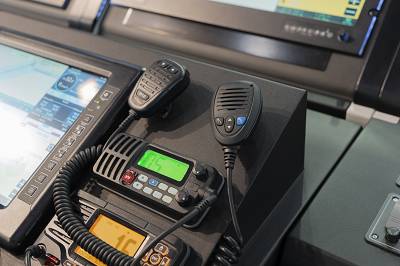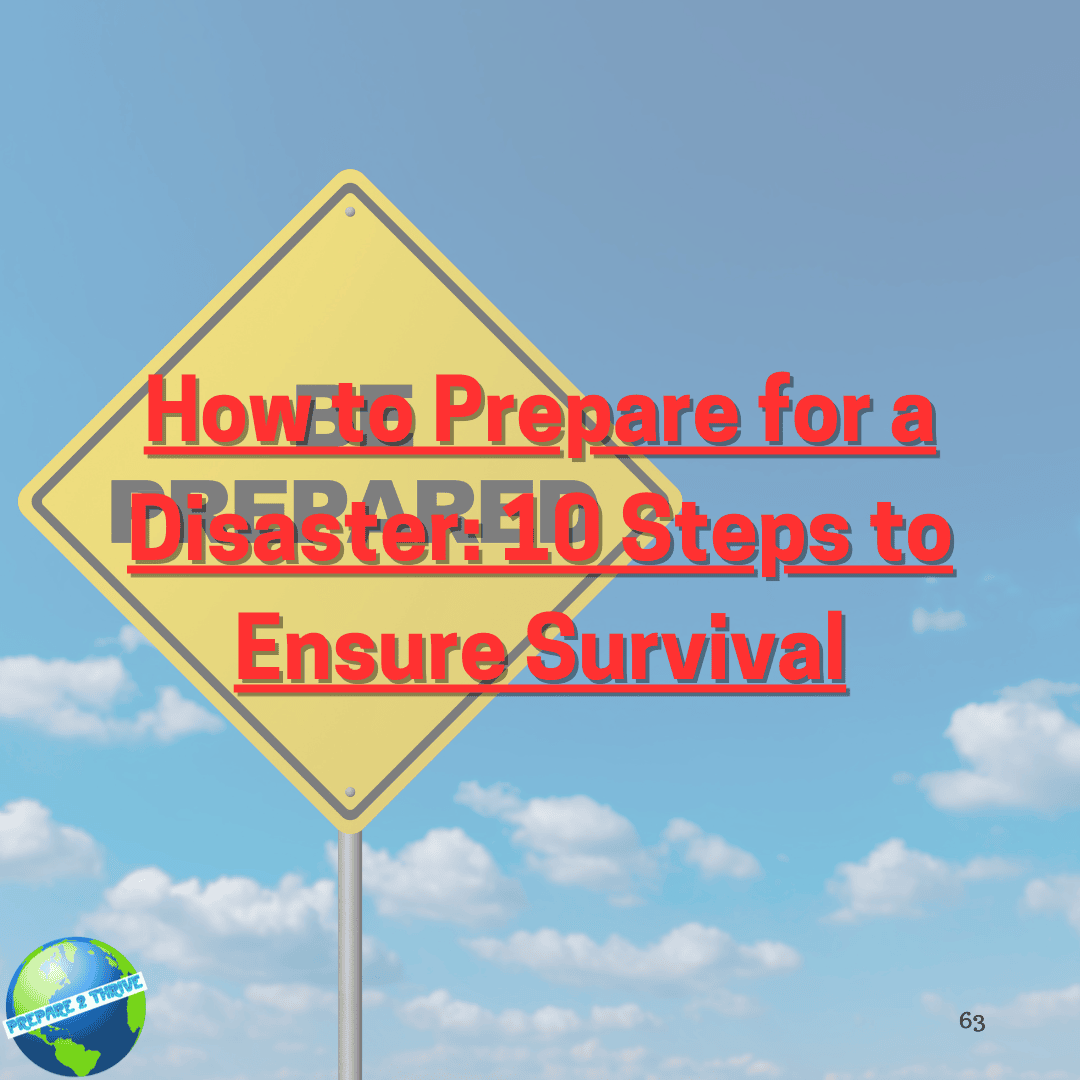Natural disasters or man-made crises can strike at any moment, leaving entire communities in chaos. When everything around you is in disarray, it can be difficult to know what steps to take to ensure your safety and that of your family. However, with some planning and preparation, you can increase your chances of survival. Here are ten essential steps to help you weather the storm.
-
Establish Communication
 In times of crisis, effective communication is essential to keep your loved ones and team members safe. The first step to preparing for an emergency is to establish a reliable means of communication with your family and team. Waiting until an emergency has already happened to develop a plan for communication can be too late, so it's important to do it as quickly as possible.
In times of crisis, effective communication is essential to keep your loved ones and team members safe. The first step to preparing for an emergency is to establish a reliable means of communication with your family and team. Waiting until an emergency has already happened to develop a plan for communication can be too late, so it's important to do it as quickly as possible.If your family members or team members are not in proximity, you'll need to develop a plan for how you'll communicate with each other during an emergency. It's crucial to keep in mind that during certain disasters, such as an EMP, communication over electrical devices may not be possible. This is why it's important to have alternative means of communication, like a ham radio, as a backup option.
It's also important to plan for different scenarios that may occur during an emergency. For example, if you and your team have decided to meet at a rally point, it's important to establish how long you'll wait there before moving to a specific destination. If you leave the rally point without your other team members, make sure you have a way to leave a hidden message for them to follow. However, it's also important to ensure that your message doesn't tip off others who are not part of your team as to where you're going.
Having a plan in place in advance will ensure that everyone knows what to do and prevent misunderstandings from arising during an emergency. Documenting your plan will also help ensure that everyone is clear on what is expected of them. Uncertainty breeds confusion, and confusion can lead to mistakes that can be costly in times of crisis.
In summary, the first step to preparing for an emergency is to establish effective communication with your family and team members. Plan for different scenarios that could potentially play out, document what you will do in each situation, and ensure that everyone is clear on what is expected of them. By doing so, you can avoid misunderstandings and stay safe in times of crisis. Once you've established communication, you can move on to the next step of your emergency plan.
-
Assess The Situation
 After establishing communication with your family or team, the next step is to assess the situation. This involves evaluating the current state of affairs and forming a plan that takes into account various possible scenarios. When everyone is together, it's essential to make informed decisions about what to do next. If you have a predetermined rally point, the first question to ask is where to go next. Is your home still a safe haven, or has it been compromised? If you plan to move to your bug-out location, is it still safe, or has it already been overrun by looters?
After establishing communication with your family or team, the next step is to assess the situation. This involves evaluating the current state of affairs and forming a plan that takes into account various possible scenarios. When everyone is together, it's essential to make informed decisions about what to do next. If you have a predetermined rally point, the first question to ask is where to go next. Is your home still a safe haven, or has it been compromised? If you plan to move to your bug-out location, is it still safe, or has it already been overrun by looters?Assuming you didn't have advanced knowledge of the event and didn't move out before it occurred, moving to a secondary location may not always be the best option. If the roads are jammed, getting stuck with a bunch of unprepared people could expose and endanger you. Bugging out into the unknown may also potentially make things worse. Therefore, you need to make some critical decisions at this point, which is why it's crucial to have these things thought through in advance.
It's essential to have a checklist that you're familiar with and that everyone on your team has rehearsed together. Having a document detailing the steps you'll take can be especially helpful. However, it's crucial not to disclose specific details on the document. If it falls into the wrong hands, it could provide critical intel to others, which could be detrimental to your safety. Altering names and locations to terms you collectively know the meaning of can help prevent you from tipping off those that may want to take advantage of the information.
In conclusion, it's essential to assess the situation and form a plan that takes into account various possible scenarios when everyone is together. By making informed decisions, you can avoid potentially dangerous situations and keep everyone on the same page. Having a checklist or document detailing the steps you'll take can be especially helpful, but it's crucial not to disclose specific details on the document. By following these steps, you can be well prepared to face any emergency situation that arises.
-
Get Home or To Bug-Out Location
 When faced with a collapse or catastrophic event, the third step is to get to your home or bug-out location based on the communication and decisions made after assessing the situation. This step requires making critical decisions in real-time based on the information available. Depending on the type of collapse, it may be necessary to decide whether to head to your home, stay at your home, or travel to a bug-out location. These decisions should be based on the intelligence you have at hand, and they may change depending on the fluidity of the situation.
When faced with a collapse or catastrophic event, the third step is to get to your home or bug-out location based on the communication and decisions made after assessing the situation. This step requires making critical decisions in real-time based on the information available. Depending on the type of collapse, it may be necessary to decide whether to head to your home, stay at your home, or travel to a bug-out location. These decisions should be based on the intelligence you have at hand, and they may change depending on the fluidity of the situation.If your current location, such as a suburban home, is not safe due to unprepared neighbors, it may not be the best location to go to. If traveling to a bug-out location is risky because the freeways are jammed, staying in place may make more sense. In another scenario, if you have advance notice of an impending event, it may be possible to move to a safer location. But this assumes that you have a backup location, and you can make it out before the roads are impassable.
Similar to step two, decision-making based on intelligence and previously defined steps is critical to the success of this step. The same framework applies to everyone, but the specifics of each situation will be different. Therefore, it's important to have a plan in place that is based on the type of contingencies you are preparing for. By having a plan and practicing it, you will be able to react correctly and make good decisions under stress.
-
Secure Your Location
 The fourth step in preparing for a collapse or catastrophe is to secure your location. In a post-apocalyptic world, people will be desperate for resources and will do anything to get them, even if it means harming others. This is why it is crucial to ensure the safety of your home and family. While firearms are an effective way to protect your home, it is important to approach this subject with caution and avoid conflict whenever possible.
The fourth step in preparing for a collapse or catastrophe is to secure your location. In a post-apocalyptic world, people will be desperate for resources and will do anything to get them, even if it means harming others. This is why it is crucial to ensure the safety of your home and family. While firearms are an effective way to protect your home, it is important to approach this subject with caution and avoid conflict whenever possible.One way to maintain security is by establishing rotations within your family or group to monitor your home. This will ensure that someone is always on watch, even when others need to sleep. It is also a good idea to make defensible spaces within your home using sandbags or other materials to protect against potential attacks.
However, if your home is no longer safe and the situation is getting worse, it may be time to move to a secondary location. This decision should be made after carefully assessing the situation and considering the risks and benefits of staying versus leaving.
In summary, securing your location is an essential step in preparing for a collapse or catastrophe. While firearms may be necessary for protection, it is important to approach this subject with caution and avoid conflict whenever possible. Establishing rotations and creating defensible spaces within your home can also help maintain security. Ultimately, the decision to stay or leave should be based on a thorough assessment of the situation and the potential risks involved.
-
Observe OPSEC
In times of crisis, keeping your information private is crucial. Operational security, or OPSEC, is a term used by the military to ensure that important information is kept confidential. For preppers, this means keeping your supplies, such as food, water, and first aid, a secret. Unless you're prepared to take care of your neighbors, it's best not to reveal that you have supplies. While helping your neighbors may be advisable in the short term during a natural disaster, it's important to be prepared for the long term. In a grid-down scenario, revealing your supplies can be dangerous. Once you reveal that you have supplies, people will start lining up at your door, and you won't be able to control the outcome.
To maintain OPSEC, it's essential to be careful about what you reveal. If you have freeze-dried meals or MREs, now is probably the best time to use them. These meals do not require cooking or preparation, which means that you won't have to reveal that you have food. Odor control is also essential. During the first few weeks of a crisis, the situation will be chaotic, and those who did prepare may not be around. Covering your windows with tarps and exercising control over your lighting at night is also important. If you have power, you'll stand out, and draw unwanted attention to yourself. It's best to put the covering behind your blinds or curtains, so people don't think you're intentionally covering your windows, which may raise questions.
In conclusion, OPSEC is crucial to ensuring your survival during a crisis. Keeping your information private and being careful about what you reveal can help you avoid drawing unwanted attention to yourself. While helping your neighbors may be advisable in the short term, it's important to be prepared for the long term. Remember, once you reveal that you have supplies, you won't be able to control the outcome, and people may start lining up at your door. Stay safe and stay prepared!
-
Blend In As Much As Possible
Point number six is about blending in as much as possible. In a survival situation, it is important to avoid drawing unwanted attention to yourself. One way to do this is by being the gray man. The gray man is someone who blends in with their surroundings and doesn't stand out. If people are lining up for supplies, stand in line with them. If everyone around you is wearing baggy or dirty clothes, do the same. Try to mimic the baseline of what is happening around you.
When you are seeking help, communicate with your neighbors and share your family's plight. It is important to commiserate with others and play the part. Look like you're experiencing hardships just like others around you. Don't shave or comb your hair, look like a mess as much as possible. The idea is to blend in and not stand out in any way.
There is a parable from Afghanistan that goes, "Beware the fat man in the skinny land." It means that everyone else was starving and enduring hardships, and this one person was not. So, what was he hiding? You don't want to be that person who stands out, as it could make you a target. Instead, find the baseline and adapt to it as much as possible. Be like everyone else to avoid being overrun for what you have.
In summary, being the gray man and blending in with your surroundings is an important strategy for survival. By mimicking the baseline of what is happening around you, you can avoid drawing unwanted attention to yourself and keep yourself and your family safe.
-
Gather As Much Intel As Possible
 In a survival scenario, being informed is crucial for survival. The longer the grid is down, the more important it is to gather as much intel as possible to stay ahead of potential threats. It is necessary to know what's going on in the world around you, what's happening in your area, and how the situation may change. The key is to be proactive rather than reactive.
In a survival scenario, being informed is crucial for survival. The longer the grid is down, the more important it is to gather as much intel as possible to stay ahead of potential threats. It is necessary to know what's going on in the world around you, what's happening in your area, and how the situation may change. The key is to be proactive rather than reactive.One way to gather information is to stay in contact with your neighbors. Knowing what's going on in your immediate area is vital for your safety. If you're not comfortable talking to your neighbors, then gathering information through other means is necessary. Basic radios and ham radios are useful to gather information from other sources. In a grid-down scenario, you may not have access to the internet or cable TV, and in such a case, having TV antennas stored away is useful to pick up signals.
Having the right intel can enable you to stay away from potential threats, and you can make proactive decisions based on the information you have. It is essential to always stay in a state of evaluating your circumstances based on the information you have. This means that you should never get caught off guard because you weren't paying attention. It is always better to be prepared for the worst-case scenario and hope for the best.
-
Avoid Large Crowds
 In a crisis, large crowds can become a hotbed for violence and chaos. People who are desperate and in panic mode will do whatever it takes to get what they need. When you're trying to survive, your first priority should be your safety. This is why point number eight in our guide is to avoid venturing out into areas with crowds.
In a crisis, large crowds can become a hotbed for violence and chaos. People who are desperate and in panic mode will do whatever it takes to get what they need. When you're trying to survive, your first priority should be your safety. This is why point number eight in our guide is to avoid venturing out into areas with crowds.The danger of going to crowded places during a crisis cannot be overstated. The stores will be packed with people fighting for the last bit of supplies. You don't want to be caught in the middle of a riot or trampled in a stampede. Not to mention, the supplies may not even be worth the risk. When a crisis hits, the time to prepare is over. You should have already gathered the necessary supplies beforehand.
However, there may be situations where you have to leave your home to get some supplies. In such cases, you must plan your route carefully and avoid the grocery stores, gas stations, pharmacies, and banks. These places will be very busy, and people will be making panic purchases. Instead, consider visiting hardware stores that may have tools you need to snap up.
It's also crucial to avoid being on the road at this point. A true without rule of law scenario can lead to chaos on the roads. In the first few weeks or months, it's best to stay at home or head to your bug-out location if you have one. Your priority should always be to keep yourself and your family safe. Remember, avoiding large crowds may not be convenient, but it could save your life.
-
Focus On Bugging-In For 2 to 4 Weeks
 In a true SHTF scenario, bugging-in for the first two to four weeks is crucial for survival. During this time, it's essential to focus on sheltering in place and minimizing contact with the outside world. This means having enough supplies on hand to last for at least two weeks, including food, water, and medical supplies. It's also crucial to have a plan in place for sanitation and waste management, as these are often overlooked in emergency preparedness.
In a true SHTF scenario, bugging-in for the first two to four weeks is crucial for survival. During this time, it's essential to focus on sheltering in place and minimizing contact with the outside world. This means having enough supplies on hand to last for at least two weeks, including food, water, and medical supplies. It's also crucial to have a plan in place for sanitation and waste management, as these are often overlooked in emergency preparedness.During this initial period, it's important to stay vigilant and maintain a low profile. Avoid drawing attention to yourself by keeping noise levels down and covering any windows or light sources at night. If possible, it's also a good idea to have a backup power source, such as a generator or solar panels, to ensure you have electricity if the grid goes down.
While bugging-in may seem daunting, it's important to remember that this initial period is crucial for survival. By staying put and minimizing contact with the outside world, you can avoid potential threats and allow the chaos to subside. Once this initial period has passed, you can then begin to assess the situation and plan for what comes next.
-
Decide The Next Steps
 In the aftermath of a disaster, the decision to stay put or leave to a safer location is a critical one. It's essential to have plans in place, and to be mobile to avoid being tied to one location. Even if the plan is to shelter in place, one should always be prepared to move if necessary. Having a bug-out bag ready with essential supplies and important documents is crucial in case of an emergency evacuation.
In the aftermath of a disaster, the decision to stay put or leave to a safer location is a critical one. It's essential to have plans in place, and to be mobile to avoid being tied to one location. Even if the plan is to shelter in place, one should always be prepared to move if necessary. Having a bug-out bag ready with essential supplies and important documents is crucial in case of an emergency evacuation.In the absence of the grid, it's crucial to stay informed and always seek out Intel to make informed decisions. Being complacent is not an option as the situation can change rapidly. Always be evaluating the situation based on the information you have and be willing to make the tough decisions if needed.
In conclusion, surviving in a post-disaster world requires a lot of preparation and planning. It's not just about stockpiling supplies but also developing skills, building a network of like-minded people, and staying informed. The key is to be proactive and not reactive, and to always be evaluating the situation and seeking out Intel. Remember, the cavalry is not coming to save you, so it's up to you to ensure the safety and well-being of yourself and your family.









